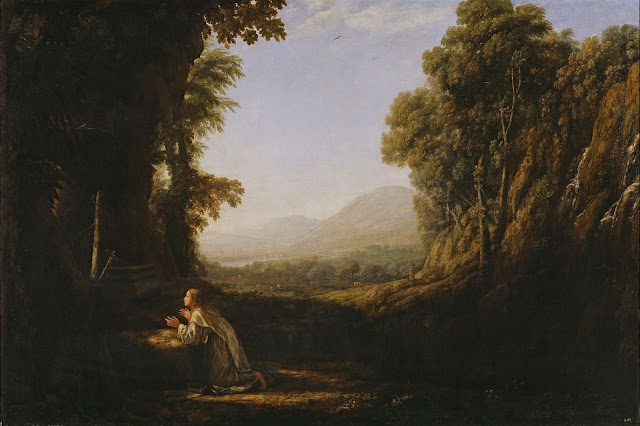 |
| Nicolas Poussin Landscape with Anchorite 1637-38 Prado |
The new-built gardens of the Buen Retiro included two chapels fitted out as hermitages. "Two men, one of them in clerical orders, were designated to serve as hermits – perhaps the first official appointments ever made to that demanding calling. The hermitage chapels were placed in their care; and on Sundays and feast days, in one of the chapels designated by the governor, the professionally qualified hermit was expected to hold mass for the Reitro staff. The joys of the spirit were not forgotten in this garden of earthly delights."
 |
| Claude Lorrain Landscape with St. Mary Magdalene 1637 Prado |
Those in charge of embellishing the Buen Retiro "commissioned from Claude and other Northern artists working in Rome one of the most spectacular and beautiful decorative ensembles of the seventeenth century – two series of landscapes, one of pastoral scenes, the other of anchorites in panoramic natural settings. Together the two groups numbered over fifty paintings."
 |
| Claude Lorrain Landscape with St. Anthony Abbot c. 1638 Prado |
"The choice of subject was directly related to one of the architectural features of the site, the hermitages. In effect, the pictures brought indoors the idea of pastoral Christianity embodied in the small garden chapels. The solemn, majestic tone of these works must have been established by Claude, who painted at least three paintings in the series."
 |
| Claude Lorrain Landscape with Anchorite c. 1638 Prado |
 |
| Jan Both Landscape with the Baptism of the Eunuch 1639-41 Prado |
 |
| Jan Both Landscape with Carmelites c. 1635-39 Prado |
"Claude's countryman Nicolas Poussin .. executed two paintings for the cycle. His Landscape with an Anchorite (at top) and Landscape with St. Mary of Egypt and the Abbot Socimas, known now only in the preparatory drawing, are among his important works of the 1630s. Claude and Poussin invited the participation of their younger disciples. Jan Both (immediately above) executed at least six pictures for the Landscape Gallery, in a style that owes as much to the tradition of Flemish landscape painting as it does to Claude. Poussin's followers, Gaspard Dughet, Jean Lemaire and Jacques d'Arthois, also participated in the program. Lemaire's Landscape with an Anchorite and Classical Ruins (immediately below) departs from the set formula by employing an improbable backdrop of assorted antique architectural forms."
 |
| Jean Lemaire Landscape with an Anchorite and Classical Ruins c. 1637-38 Prado |
 |
| Herman van Swanevelt Landscape with Anchorite in Chains c. 1634-38 Prado |
 |
| Herman van Swanevelt Landscape with San Benito de Nursia c. 1634-39 Prado |
 |
| Herman van Swanevelt Landscape with Carthusian c. 1636-38 Prado |
 |
| Gaspard Dughet Landscape with Anchorite Preaching to Animals 1637-38 Prado |
The exceptional contemporary reverence felt for the work of Claude Lorrain "led to a final commission of four landscapes in a vertical format that are considered to be the first works in the grand style of the artist's maturity. The paintings were conceived as two pairs, one with scenes from the Old Testament, the other with scenes from the lives of saints." Immediately below, the final pair with lives of saints –
 |
| Claude Lorrain Embarkation of St. Paula 1639 Prado |
 |
| Claude Lorrain Landscape with Burial of St. Serapia 1639-40 Prado |
 |
| Diego Velázquez St. Anthony Abbot & St. Paul the Hermit c. 1633 Prado |
The concluding picture, an astonishing & air-filled "landscape with hermits" by Velázquez (immediately above), was singled out to hang inside one of the two garden Hermitages (where the resident hermit could ponder its beauties at leisure).
I am grateful for the reproductions made available by Museo del Prado.